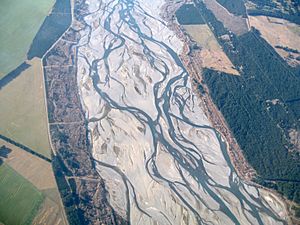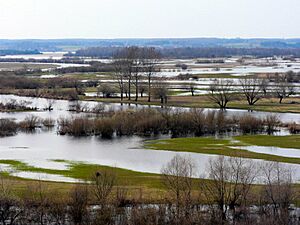Braided river facts for kids
A braided river is a type of river that looks like a braid. Instead of flowing in one main stream, it splits into many smaller channels. These channels weave around little islands that are often not fixed in place. This means the river's paths can change over time as it spreads out across a flat area.
Braided rivers form in places where the river carries a lot of sediment, like sand, gravel, and mud. They also form when the river slows down and spreads out over a wide, flat area. The huge river delta of the Amazon River is a great example of a braided river system on a very large scale. The Waimakariri River in New Zealand is a good example on a smaller scale.
Where Can We Find Them?
Large braided river systems can be found all around the world. Some of the most well-known places include:
- Alaska
- Canada
- The South Island of New Zealand
- The Himalayas mountain range
These regions often have young mountains where rocks break down quickly. This process, called erosion, creates a lot of sediment that rivers can carry.
In Europe, there are two famous braided rivers:
- The Narew River, which flows through Poland and Belarus.
- The Tagliamento River, located in northeastern Italy.
Related pages
Images for kids
-
The Rakaia River in the South Island of New Zealand is braided over most of its course
-
Brahmaputra River seen from the Space Shuttle
-
Waimakariri River with the Southern Alps in the background, Canterbury, New Zealand
-
Rakaia River, South Island, New Zealand
See also
 In Spanish: Río trenzado para niños
In Spanish: Río trenzado para niños












